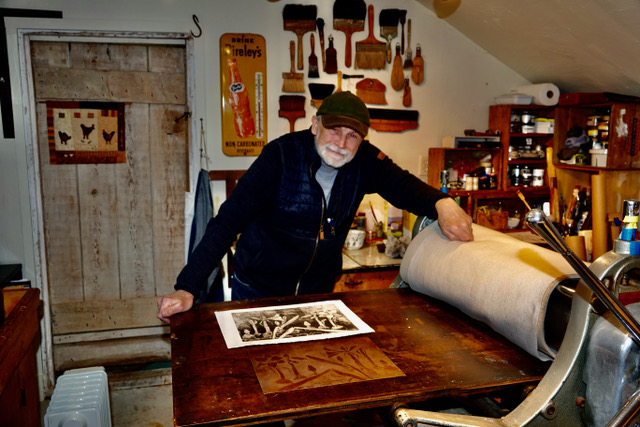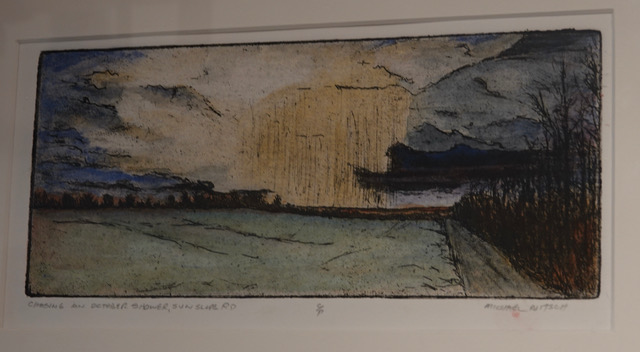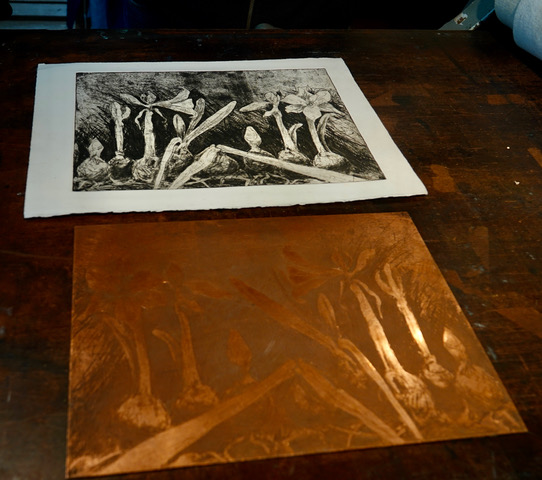Michael Nitsch: The Evolution of an Artist
- Share
- Tweet
- Pin
- Share

It was a cold, wet day in March when I interviewed Michael Nitsch at his home. The ground squished beneath our feet as we walked to the old chicken coop that is now his printmaking studio, but he was cheerfully looking forward to spring, when his interests in gardening and printmaking come together as he grows plants and creates prints around his favorite themes: flora and landscapes.
After retiring last year from his position as museum assistant at the Miller Art Museum in Sturgeon Bay, Nitsch developed a summertime routine of waking at 4 or 5 am, having two cups of coffee and then heading to his print studio for a few hours.
His interest in landscapes has grown over the years.
“It took me a while, but now I do a lot of landscapes,” he said. “What that’s done for me is it got me into a lot of nature study, and seeing how things could be conserved.”

Nitsch has been a museum professional for his entire career and feels fortunate to have worked at art museums in Racine, Wisconsin, and Sturgeon Bay that grew significantly during his tenure.
“I’ve seen the Miller’s collection grow and expand,” he said. “I’ve seen a lot of Door County’s history developed there.”
Nitsch began his museum career at the Charles A. Wustum Museum in Racine when it was housed in a donated farmhouse. It became the Racine Art Museum (RAM) in 2000, expanding into the old M&I Bank building downtown, where it helped to spur an urban revitalization.
Through his museum work, Nitsch has learned about different art media. To get a better idea of how to handle various materials, he’s taken courses in how the materials are used and how objects are made.
“That gave me an idea how to care for a collection – storing and moving objects, taking care of them,” he said. “At the RAM, I had four assistants whom I trained, and they worked very well on helping me with the collection.”
Nitsch’s own work was carried by the Two Fish Gallery in Elkhart Lake, Wisconsin, until the owners decided to focus more on their own ceramics. While he looks for another gallery that’s interested in showing his work, he’ll continue to enter competitions – most recently sending six prints to a contest in Michigan – in order to network and give his work exposure.
As for selling his creations to collectors, Nitsch said he wants to see them go to those who will enjoy and display them.

“I do small editions,” he said. “I don’t want my artworks in a drawer or dry-rotting. I’d rather get it out there.”
Nitsch said his work has become more abstract over the years, but he adds some details to help the viewer make sense of the scene. Still, he can’t resist putting a little mystery into at least some of his prints and occasionally does social commentary.
“I’m working on a print for a show that’s coming up in Oshkosh that deals with environmental things,” he said. “It’s called ‘Your Dreams Create Our Nightmares.’”
The idea, Nitsch explained, stems from the land that’s destroyed by people who want that special lake or woods view, and they “end up putting up 3,000-, 4,000- or 5,000-square-foot buildings in the middle of a forest and start displacing animals, destroying plants,” he said.
He said printing is slow work, but perhaps “deliberate” is the better word for it.
“If you want faster, you should use your computer,” Nitsch said. “I do everything in a slow pace, but now there’s sort of the charm, too. I come in here, and I just throw on some great CDs, and it puts me in the groove.”

